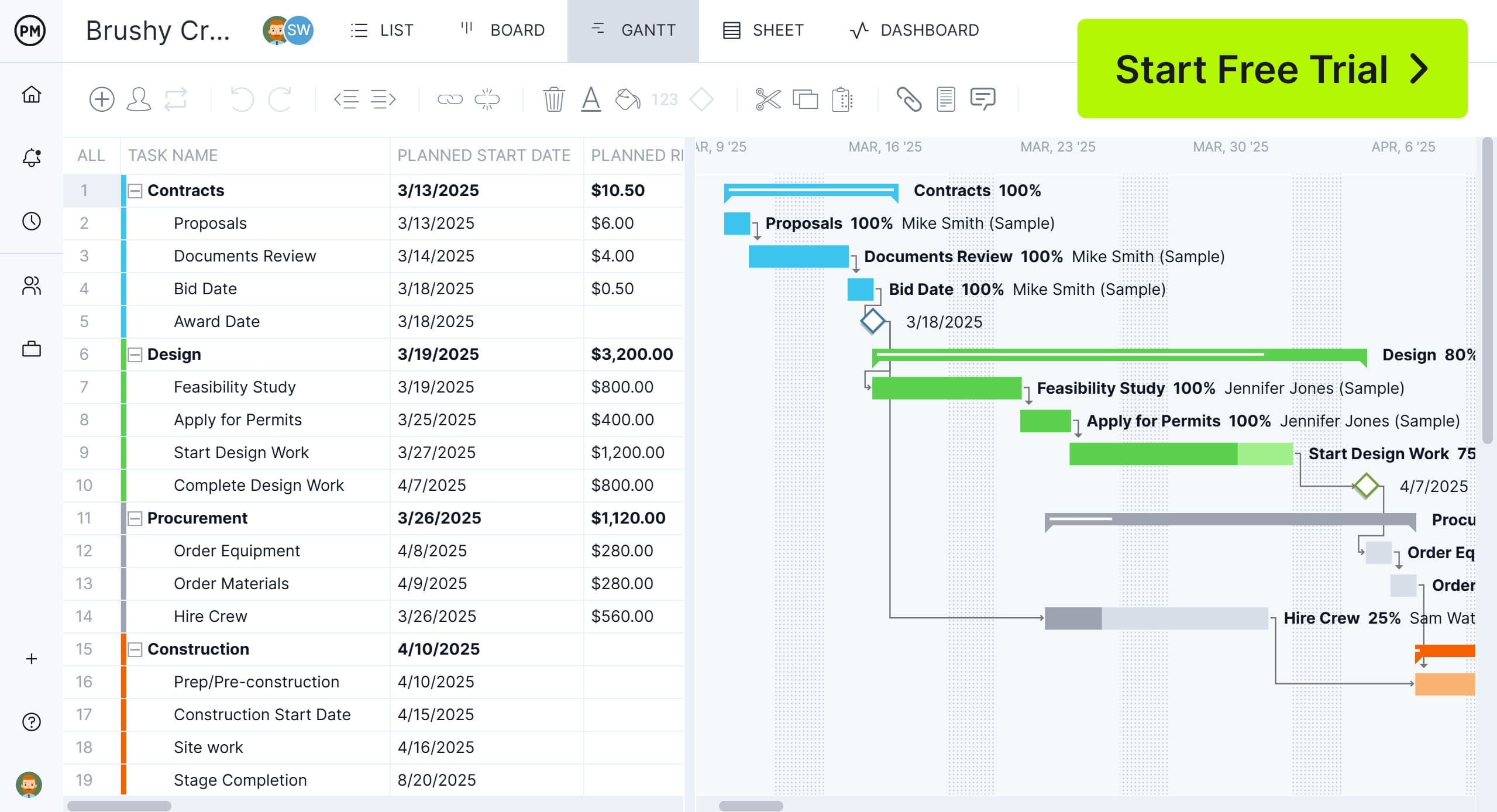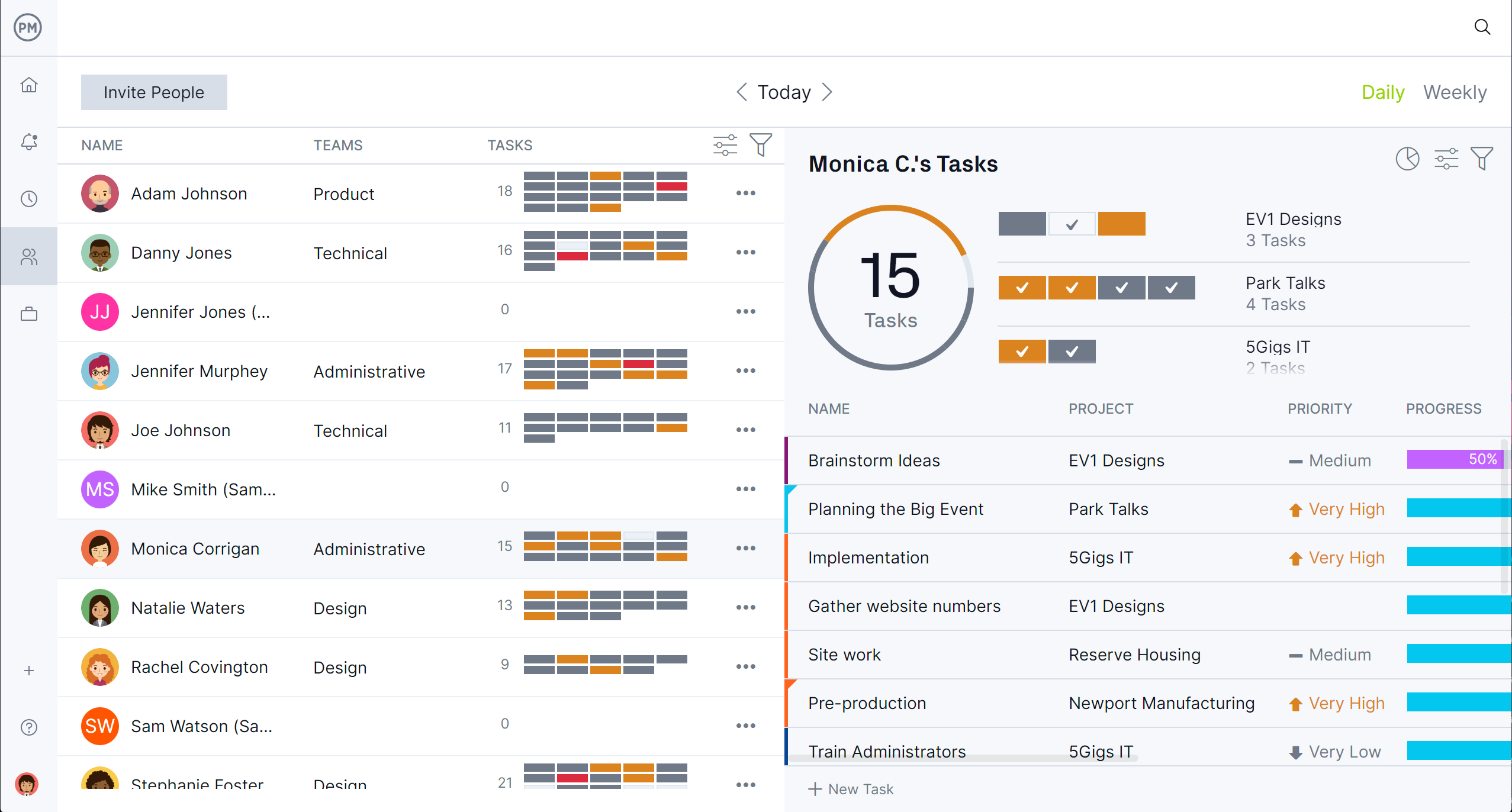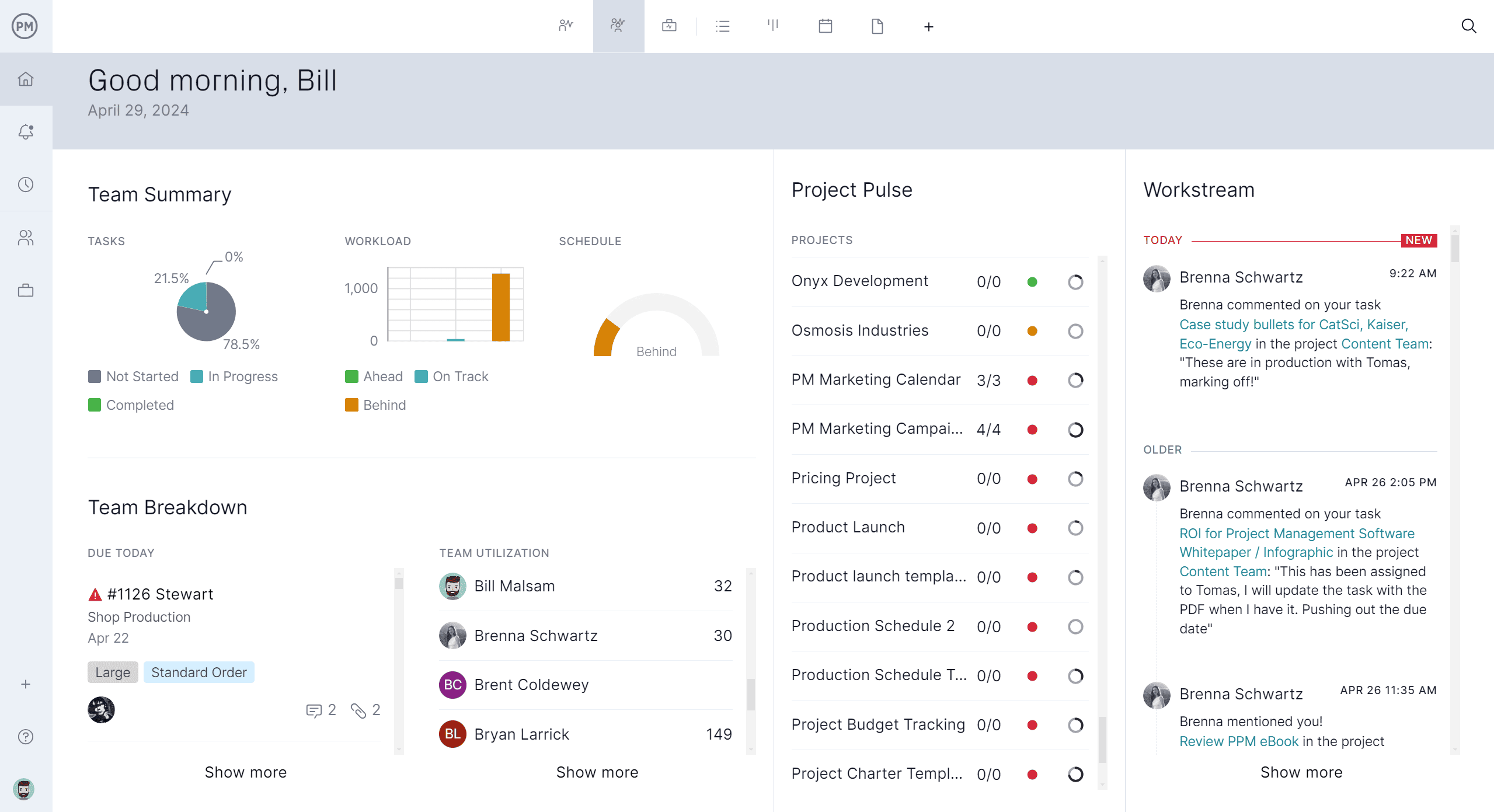The project planning phase is a crucial stage in the project management lifecycle where the foundation for successful execution is laid. During the planning phase of project management, teams establish the project’s scope, set clear objectives and define how and when tasks will be completed. Planning ensures that everyone involved understands the direction and requirements, minimizing uncertainty and aligning efforts from the start.
Let’s look deeper into the project management planning phase, including defining it and listing the phase’s key activities and outcomes. While project management software is recommended for managing the planning phase in project management, for those not ready to upgrade, we’ll end with a few free planning templates.
What Is the Project Planning Phase?
The project planning phase is the second stage in the project management life cycle, following project initiation. It involves creating a comprehensive roadmap that outlines how the project will be executed, monitored and closed. The goal is to break down the project’s objectives into manageable tasks and determine the best approach to meet those objectives on time and within budget. This phase also identifies key stakeholders, establishes communication protocols and defines success criteria, ensuring everyone is aligned before execution begins.
Central to the project planning phase are tools and documents like the project scope statement, work breakdown structure (WBS), project schedule (often illustrated using a Gantt chart), resource management plans and risk assessments. These tools help project managers visualize the work ahead, allocate the right people and resources and prepare for potential challenges. By planning thoroughly, project teams can reduce the risk of scope creep, budget overruns or timeline delays.
Ultimately, the planning phase serves as the backbone of the entire project. It enables teams to anticipate dependencies, set realistic expectations and establish controls to measure progress. A well-developed project plan not only guides day-to-day work but also builds confidence among stakeholders by showing how the team intends to deliver value and manage change effectively. Project managers and their teams need support for the project planning phase and all other phases in the project’s life cycle, with project management software.
ProjectManager is award-winning project and portfolio management software that has robust Gantt charts that are ideal for the planning phase of the project and beyond. That’s because they can schedule tasks, resources and costs, add milestones and assign team members. But our Gantt chart goes beyond the basics and links all four types of task dependencies to avoid cost overruns, filters for the critical path to identify essential tasks and slack, plus can set a baseline to track progress and more in real time so projects stay on schedule. Get started with ProjectManager today for free.


Key Activities of the Project Planning Phase
The project planning phase is where ideas and goals begin to take shape as actionable strategies. It’s a critical period where project managers and teams translate high-level concepts from the initiation phase into concrete steps that guide execution. Below are the key activities that define this phase and help ensure the project is aligned, well-organized and ready for implementation.
Scope Definition
Scope definition is the process of clearly identifying what is and isn’t included in a project. It sets the boundaries for the work to be completed and provides a detailed description of deliverables, requirements and constraints. By establishing a clear scope, project teams can manage expectations, prevent scope creep and ensure everyone is aligned on the project’s objectives and limitations.
Schedule Development
Developing a project schedule involves sequencing tasks, defining durations, identifying dependencies and determining milestones. Tools like Gantt charts and critical path analysis help visualize the timeline and ensure that activities are organized logically. A well-structured schedule keeps the team on track and makes it easier to adjust plans when delays or changes occur.
Cost Estimation
Cost estimation involves forecasting the financial resources needed to complete the project. This includes labor, materials, equipment and other direct and indirect costs. Accurate estimates are essential for budgeting and help project managers make informed decisions about resource allocation and potential trade-offs.
Risk Assessment
Risk assessment identifies potential issues that could impact project success. Risks are documented in a risk register along with their likelihood, impact and mitigation strategies. By anticipating risks early, project teams can reduce uncertainty and improve their ability to respond proactively to challenges.
Resource Planning
Resource planning ensures that the right people, tools and materials are available when needed. It involves assigning roles and responsibilities, forecasting workload and identifying potential resource constraints. This step is crucial to prevent bottlenecks and ensure optimal team performance throughout the project lifecycle.
Communication Planning
Communication planning defines how information will be shared among stakeholders and team members. It includes choosing communication methods, establishing frequency and assigning responsibility for updates. A solid communication plan fosters transparency, accountability and collaboration across the project.
Stakeholder Analysis
Stakeholder analysis involves identifying all individuals and groups affected by the project, understanding their interests and influence and planning how to engage them effectively. Recognizing stakeholder needs and expectations early helps secure support and reduces the risk of resistance or conflict later in the project.
Key Outcomes of the Project Planning Phase
The project planning phase doesn’t just involve strategizing—it delivers tangible outputs that become essential tools throughout the rest of the project. These key outcomes provide structure, visibility and control, enabling teams to execute efficiently and make informed decisions. Each document or tool serves a specific purpose in aligning stakeholders, managing resources and tracking progress.
Work Breakdown Structure
The work breakdown structure decomposes the project into smaller, manageable tasks or work packages. It creates a visual hierarchy of all deliverables, helping project managers assign responsibilities, estimate resources and monitor progress more effectively.
Critical Path Diagram
This diagram outlines the sequence of dependent tasks that determine the shortest possible project duration. By identifying the critical path, teams can focus on tasks directly impacting the timeline and adjust accordingly to avoid delays.
Risk Register
A risk register is a living document that lists all identified risks, their potential impact, likelihood and mitigation strategies. It serves as a central reference for risk monitoring and management throughout the project lifecycle.
Project Budget
The project budget compiles all estimated costs, including labor, materials, equipment and contingency reserves. It’s a foundational element for tracking spending and ensuring the project stays financially on track.
Project Schedule
The schedule details the start and end dates of all project activities, key milestones and dependencies. Often visualized using Gantt charts, it guides day-to-day work and provides a timeline against which progress is measured.
Project Baseline
The baseline integrates the approved scope, schedule and budget into a fixed reference point. It measures actual performance and detects variances during execution, enabling corrective actions when necessary.
Project Scope Statement
This document defines the project boundaries, including deliverables, assumptions, constraints and acceptance criteria. It ensures all stakeholders have a shared understanding of what will be delivered and how success will be measured.
Project Management Plan
The project management plan consolidates all planning documents into one cohesive framework. It outlines how the project will be executed, monitored and controlled, serving as the master guide for the project team and stakeholders.
Free Project Planning Phase Templates
As promised, below are some free project management templates that can be downloaded from our site. There are over 100 free templates for Excel and Word that cover all aspects of managing projects across multiple industries. We’ve chosen just a couple that can help with the project planning phase.
Project Budget Template
This free project budget template for Excel is used to estimate, allocate and track the financial resources needed to complete a project. It includes detailed line items for costs such as labor, materials and more. The template can also organize these costs by project phase, task or department to provide a clear and comprehensive financial overview.
Project Plan Template
Download this free project plan template for Word to organize and communicate the core elements of a project plan. It provides a structured framework that helps project managers outline key components such as project objectives, scope, deliverables, timelines, resources, risk management strategies and stakeholder roles. This template is a blueprint for guiding the project’s execution from start to finish, ensuring consistency and alignment among team members.
Project Scope Template
Use this free project scope template for Word to define and document the boundaries of a project. It outlines what is included in the project, such as deliverables, tasks and objectives, as well as what is excluded. The template includes sections for the project goals, milestones, key stakeholders, assumptions, constraints and criteria for project success or acceptance.
How ProjectManager Helps With the Project Planning Phase
The project planning phase, as we’ve noted above, is the frame on which the entire project hangs. While templates can provide that outline, they’re not recommended as planning tools except in the smallest, simplest projects. That’s because templates are static documents that are not equipped to handle the dynamic nature of planning, managing and tracking projects.
ProjectManager is award-winning project and portfolio management software with planning tools, but also multiple project views that update in real time to manage tasks, resource management and tracking features that give project managers and their teams the live data they need to keep projects on schedule.
Plan and Monitor Resources
The project planning phase includes allocating resources effectively and efficiently. This begins with the Gantt chart, scheduling human and nonhuman resources, and then setting team availability during onboarding. To view allocation across one or more projects, visit the color-coded workload chart.
It shows who is overallocated or underutilized, and the team’s workload can be balanced without leaving the chart. There’s also a team page that summarizes the daily or weekly activities of the team. It can be filtered by progress or priority, and tasks can be updated from the page.


Track Progress With Real-Time Dashboards and Reports
More than just resources need to be monitored and controlled. For a high-level overview of more project metrics, toggle to the real-time project or portfolio dashboards. They don’t require any setup and collect live data displayed on easy-to-read graphs and charts that show time, cost, workload and more.
For more details, use our customizable reports on status, variance, workload, timesheets and more. All can be filtered to focus on key data points or share a progress report with stakeholders to keep them informed. Secure timesheets also help by tracking labor costs to stay on budget.


Related Project Planning Content
We’ve just scratched the surface of the project planning phase, but there’s much more to learn. For those who want to further their knowledge, check out the links below to some of our recently posted pieces on the subject.
ProjectManager is online project and portfolio management software that connects teams whether they’re in the office or out in the field. They can share files, comment at the task level and stay updated with email and in-app notifications. Join teams at Avis, Nestle and Siemens who use our software to deliver successful projects. Get started with ProjectManager today for free.







